This first table shows the Nemesis 280 GTX’s Watts/10 Delta Temp numbers in a quick glance chart format.

Using this data we can effectively show percentage gains/losses relative to a reference point. It’s an interesting way to show gains/losses while changing a variable.
So, let’s focus on 1300 RPM as our reference and see how much gain or loss in performance we get by changing fan speed.

From these results we see a large drop in performance of from 1300 rpm to 750 rpm particularly at Push Only. The excellent increases from 1300 rpm to 1850 rpm were the best gains of the entire group and again indicates the strong performance results achieved using high speed fans..
So from the data above we’re getting a good idea of how the Nemesis 280 GTX radiator performs relative to itself. But there is a large selection of 280mm radiator models to choose from, so let’s put the it’s results into some comparison charts.
Push Only Data vs Competition
In general, thicker radiator perform better than thinner radiators of the same size (fan capacity) but a lot also has to do with how each core has been designed / tuned; number of tubes, thickness of tubes, fin array etc.
If it were thickness alone we should expect the Nemesis 280 GTX to always be near the top of the rankings and our testing would be totally unnecessary.
Focusing on the Push Only results for now, let’s see how the Nemesis 280 GTX’s performance compares to the competition.
Let’s start with 750 RPM.

From the data we reviewed already we should all have known that Push Only 750 RPM was likely to be a weak point for the Nemesis 280 GTX. That it finished so far down the rankings was a bit of a surprise. Lucky this is a very closely contested data point and the gap between it and 1st place was no more than ~11%. Needless to say, if you want to set up a Push Only low speed fan assembly, there are better options available.
Now let’s look at 1300 rpm:
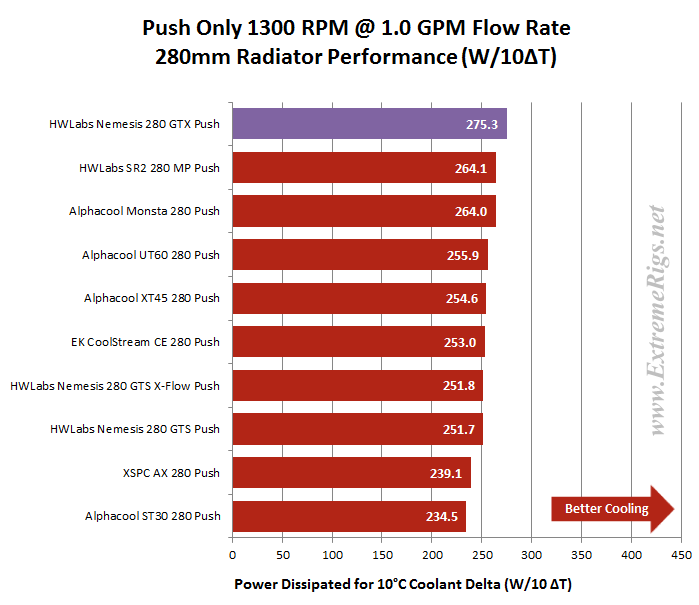 What a difference the result is with more airflow through the Nemesis 280 GTX. From 2nd last at low fan speed to 1st position with medium fan speeds, and not by a small margin. The Nemesis 280 GTX has a clear advantage and this is an ominous sign for other radiators in the test group.
What a difference the result is with more airflow through the Nemesis 280 GTX. From 2nd last at low fan speed to 1st position with medium fan speeds, and not by a small margin. The Nemesis 280 GTX has a clear advantage and this is an ominous sign for other radiators in the test group.
Now 1850 rpm Push Only:
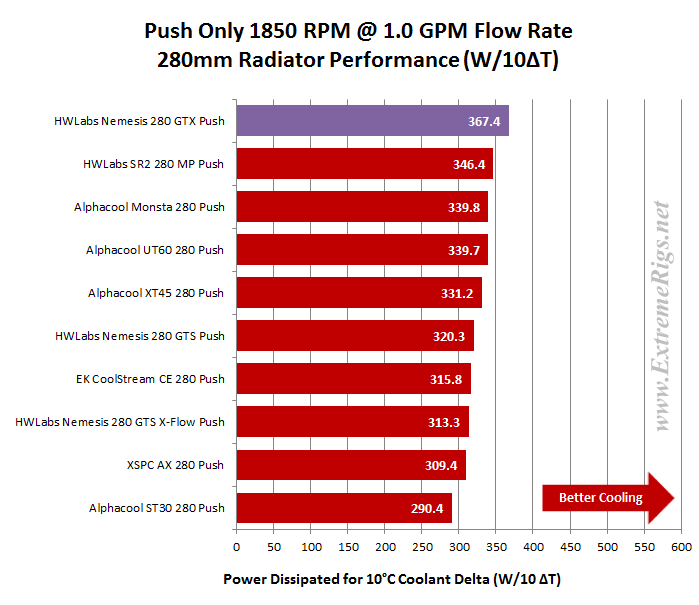 At 1850 rpm the Nemesis 280 GTX again takes 1st place and is ~6% ahead of it’s closest rival.
At 1850 rpm the Nemesis 280 GTX again takes 1st place and is ~6% ahead of it’s closest rival.
Let’s find out how the Nemesis 280 GTS performs with Push/Pull fans.
Push/Pull Data vs. Competition
Firstly the 750 rpm:
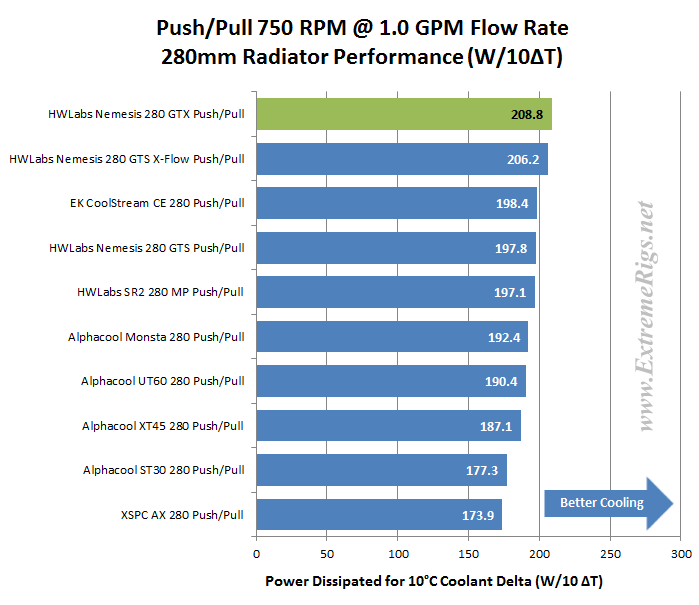 With a 28% increase in performance over it’s Push Only result, the Nemesis 280 GTX catapults into 1st position for the Push/Pull 750 rpm comparison (it was 2nd last at Push Only 750rpm).
With a 28% increase in performance over it’s Push Only result, the Nemesis 280 GTX catapults into 1st position for the Push/Pull 750 rpm comparison (it was 2nd last at Push Only 750rpm).
Let’s move to 1300 rpm:
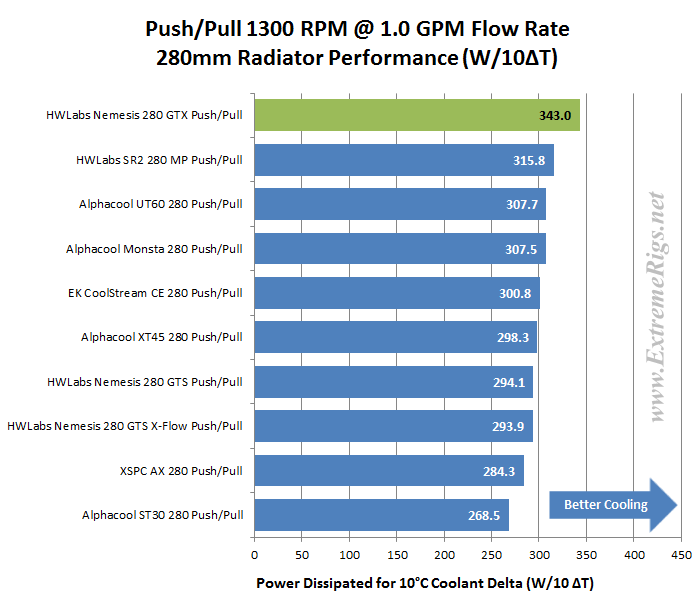 At this data point the Nemesis 280 GTX continues the streak of 1st places and now has a clear performance advantage over the closest competitor. With a lead of ~8% it seems there is no stopping the performance domination it has over other radiators in the 280mm range.
At this data point the Nemesis 280 GTX continues the streak of 1st places and now has a clear performance advantage over the closest competitor. With a lead of ~8% it seems there is no stopping the performance domination it has over other radiators in the 280mm range.
Now 1850 rpm:
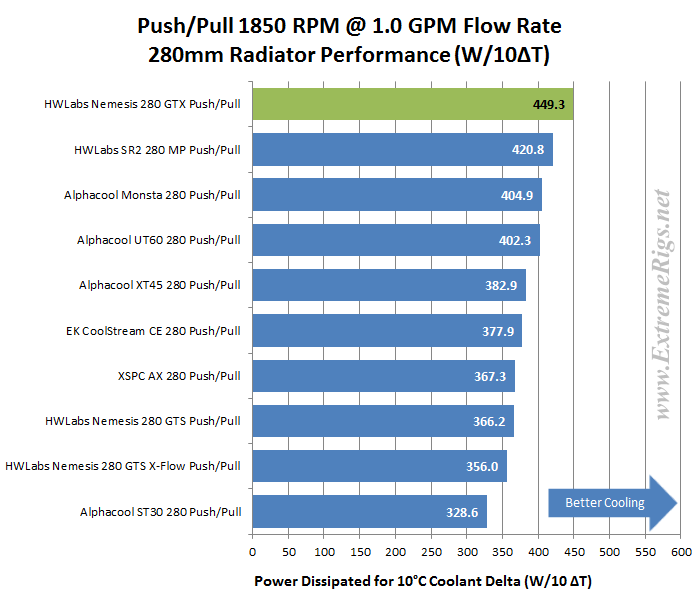 At 1850 rpm Push/Pull the Nemesis 280 GTX is again the clear winner with ~450 Watts of power dissipated after a mathematical adjustment to a 10°C air/coolant delta from our 300 watt applied load. Impressive!
At 1850 rpm Push/Pull the Nemesis 280 GTX is again the clear winner with ~450 Watts of power dissipated after a mathematical adjustment to a 10°C air/coolant delta from our 300 watt applied load. Impressive!
Let’s now combine the Push Only and Push/Pull results of our 1.0 GPM flow rate tests. Sometimes these combined plots show up points of interest, though they can get a little busy and perhaps confusing if you’re not used to them.
750 rpm first:
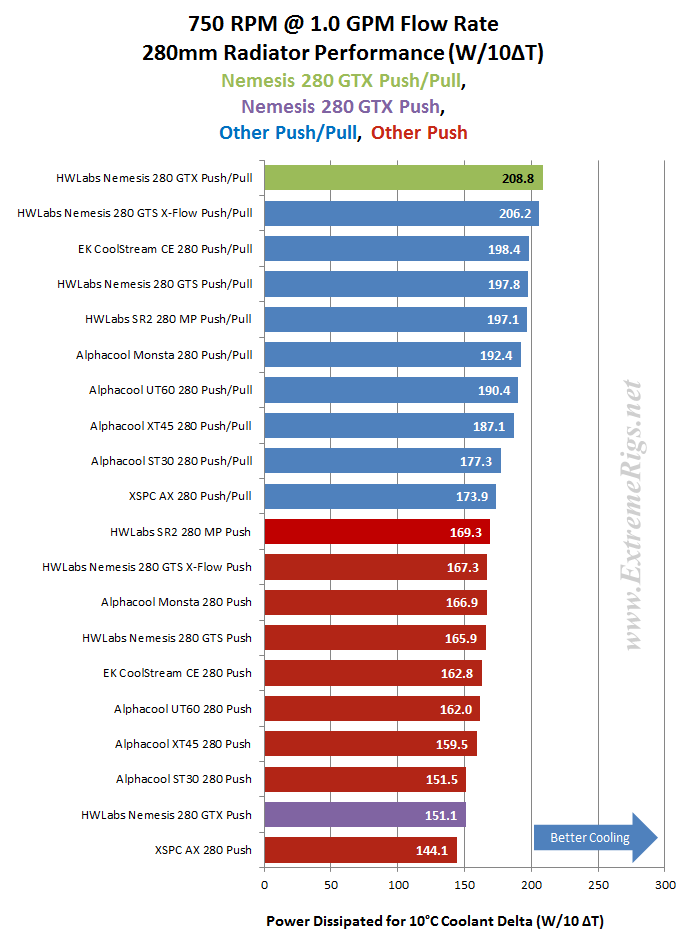 WOW! One results at the very top and another 2nd from the bottom.
WOW! One results at the very top and another 2nd from the bottom.
At 1300 rpm the Nemesis 280 GTX’s Push Only result has beaten the worst Push/Pull results. Not a bad trick given that it is thinner overall with just a single fan (just thinner mind you, by 1mm).
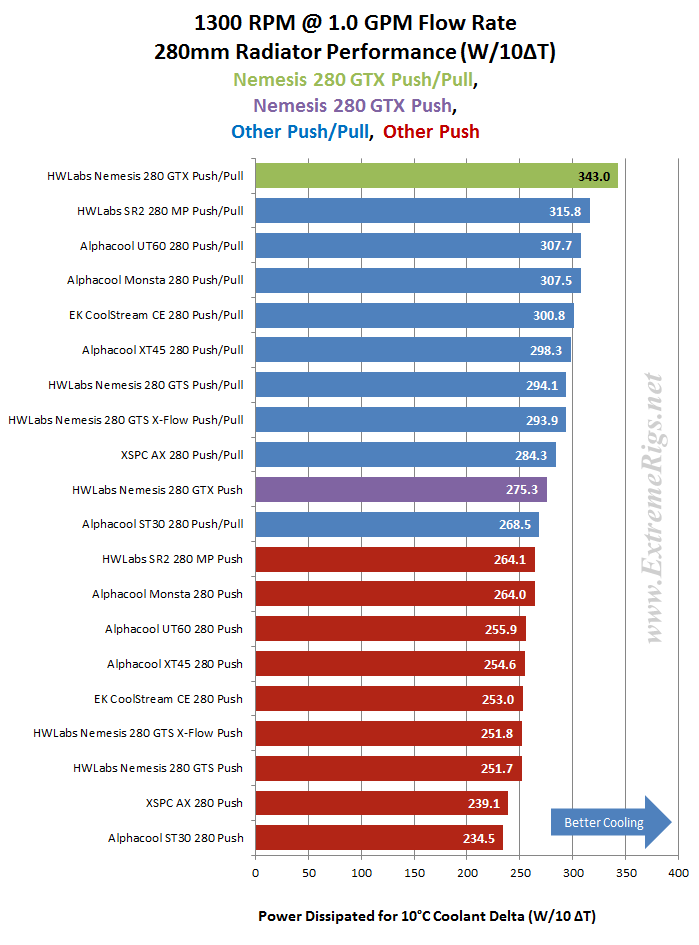 At 1850 the dominance of the Nemesis 280 GTX in Push/Pull is evident taking top spot. BUT more impressive is that it’s Push Only result has beaten half of the competitor’s Push/Pull results.
At 1850 the dominance of the Nemesis 280 GTX in Push/Pull is evident taking top spot. BUT more impressive is that it’s Push Only result has beaten half of the competitor’s Push/Pull results.
Maybe even more amazing, is that it’s Push Only result is only ~13% behind the best of the other radiators Push/Pull effort.
Another view of the same data, this time plotted as curves and some extrapolation added.
Be warned these plots can be hard to read given that many results are similar at the same data points.
Again the Push Only data first:
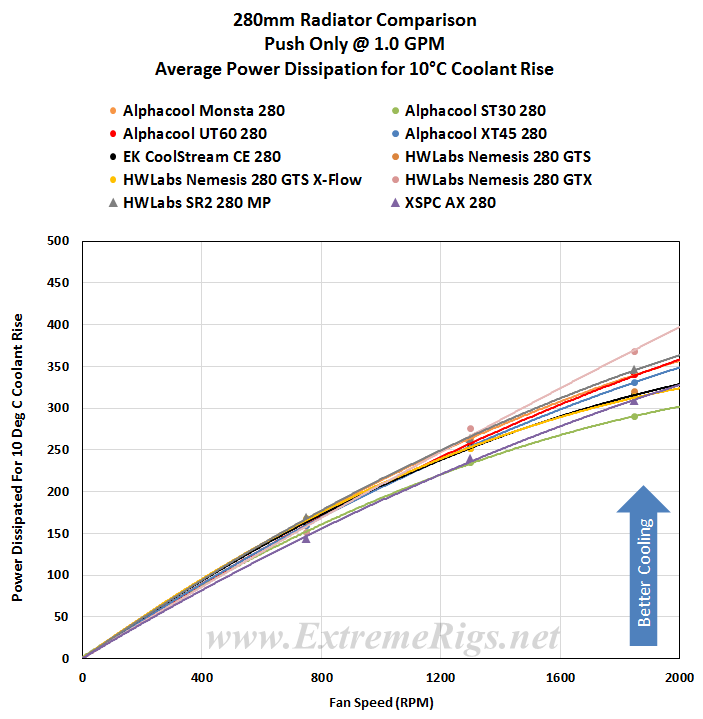 This perhaps best shows just how close the results are, particularly with low speed fans.
This perhaps best shows just how close the results are, particularly with low speed fans.
Because the data curves in plot above are almost blurred into one another, we have split it into two separate plots; 750 rpm to 1300 rpm and 1300 rpm to 1850rpm and zoomed in on those fan speed zones.
Now the Push/Pull results are plotted, again followed by split and zoomed versions.
Average Performance Factors
For every radiator tested we create APF “Average Performance Factor” charts from both the Push Only and Push/Pull results. We also make a combined plot of the average called the “Master Performance Factor”. The radiator with the best cooling ability (W/10ΔT) at each rpm is awarded a score of 100 and every other radiators W/10ΔT result is scored as percentage of the top performer.
This way of looking at the comparison takes away any advantages that a radiator may have at higher or lower fan speeds and looks at an overall average. While this appears fair it does tend to favor those radiators that are all-rounders and those radiators which do very well at high RPM. Most users should be more focused on their specific use case.
Here are the Nemesis 280 GTX’s percentage scores at each data point:
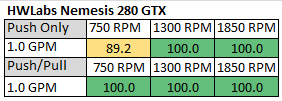 This table probably doesn’t need much further explanation. Clearly we see a dominant set of results. In fact the Nemesis 280 GTX was so dominate that it made some other radiators scores look very very weak in comparison.
This table probably doesn’t need much further explanation. Clearly we see a dominant set of results. In fact the Nemesis 280 GTX was so dominate that it made some other radiators scores look very very weak in comparison.
The percentage numbers in the table above offer another way of looking at the Nemesis 280 GTX’s results. But for our scoring system we need a way to reduce the categories while retaining the data. To do this we average the results for each fan assembly type giving us Averaged Performance Factors. We calculate this for Push Only, Push/Pull and finally an average of everything.
Firstly – the Push Only APF:
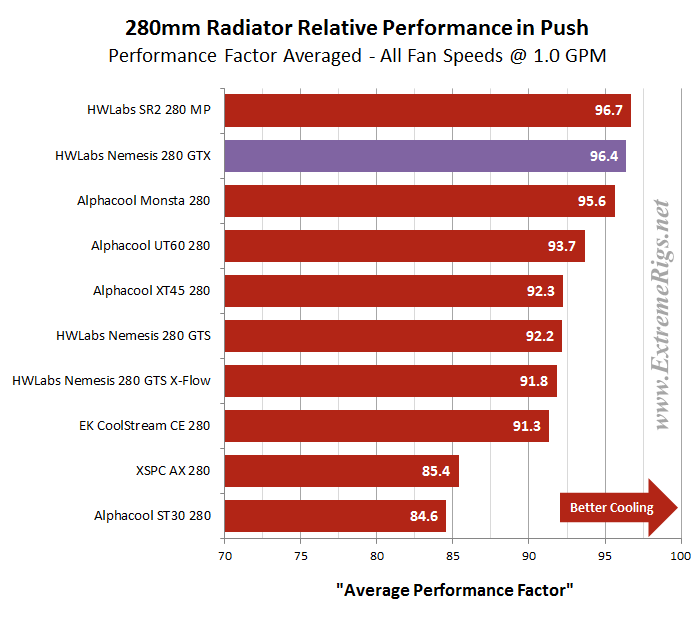 With an 96.4 % Averaged Push Only result the Nemesis 280 GTX places equal 1st (after test error margin is factored in) with it’s SR2 stablemate that is 6mm thicker. The score is a result of two 1st places and one 2nd last.
With an 96.4 % Averaged Push Only result the Nemesis 280 GTX places equal 1st (after test error margin is factored in) with it’s SR2 stablemate that is 6mm thicker. The score is a result of two 1st places and one 2nd last.
Now the Push/Pull APF:
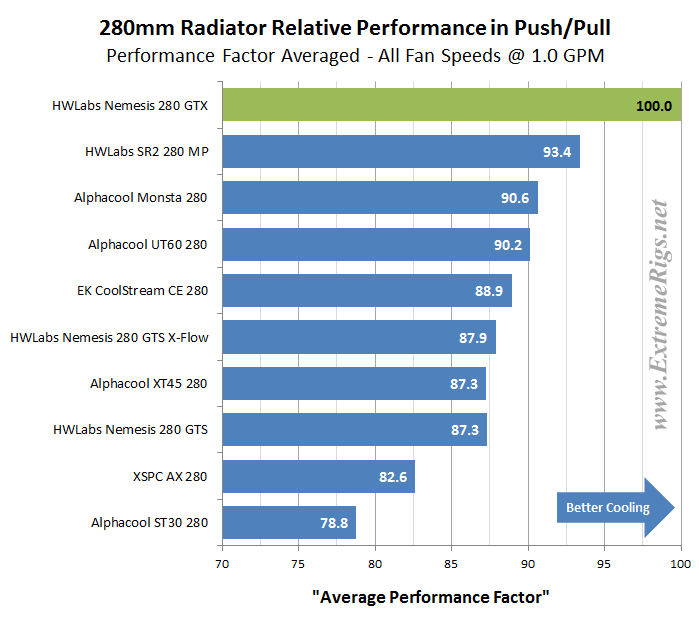 Nothing was able to beat the Nemesis 280 GTX with a Push/Pull fan assembly. It placed 1st in each of the 3 thermal tests and therefore it has achieved a remarkable 100% score, which may be an ER testing first.
Nothing was able to beat the Nemesis 280 GTX with a Push/Pull fan assembly. It placed 1st in each of the 3 thermal tests and therefore it has achieved a remarkable 100% score, which may be an ER testing first.
Finally we created the Master Performance Factor which is calculated from the averaged results of all the Push Only and Push/Pull thermal tests, at all fan speeds.
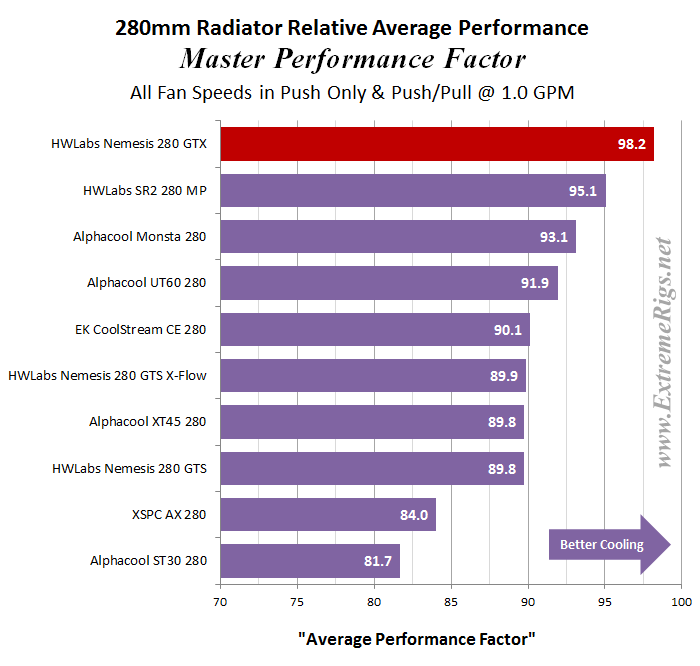 Even it’s relatively poor result in Push Only with low speed fans was unable to hold back the overall score for the Nemesis 280 GTX. The APF score of 98.2 is again evidence of just how good it’s thermal performance test results were.
Even it’s relatively poor result in Push Only with low speed fans was unable to hold back the overall score for the Nemesis 280 GTX. The APF score of 98.2 is again evidence of just how good it’s thermal performance test results were.
Space Efficiency
The Nemesis 280 GTX’s space efficiency vs. performance ranking is not likely to be very good as thinner radiators almost always produce better results here than their thicker counterparts. We have used the Average Performance Factor results from the charts above to compile two plots which shows us how it compares to the other rads in terms of performance Vs. space taken.
First up is Radiator Thickness Vs. APF
Here the combined APF scores were divided by the radiator thickness only, with the highest (most space efficient) issued a score of 100. Each of the other radiators results was converted to a percentage of the most space efficient radiator’s score.
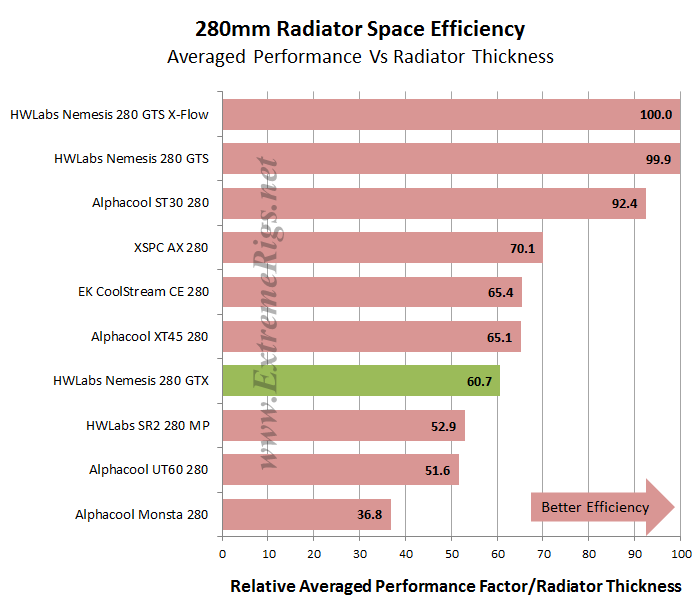 The order has ended almost in order of thinnest to thickest and as anticipated the Nemesis 280 GTX ranked accordingly.
The order has ended almost in order of thinnest to thickest and as anticipated the Nemesis 280 GTX ranked accordingly.
Next we took the APF results for Push/Pull and divided it by the total thickness including the fans and applied the same scoring system. For the Push Only we used the Push Only Vs Push/Pull comparative results and applied the same scoring system when compared against the Push/Pull.
This plot is likely the most useful of the 2 plots for readers looking at space efficiency.

With fan thickness factored in the Nemesis 280 GTX’s Push/Pull result significantly improves and places 4th, while Push Only has the same ranking as previously we saw in the previous plot.
Value Factor
While our APF’s are still fresh in mind, let’s now look at some Performance vs Price results to show which of the 280mm radiators might offer the best bang for your buck. Each radiator’s combined APF scores were divided by the radiator cost and again we applied our scoring system of percentage Vs. the best performer of the category.
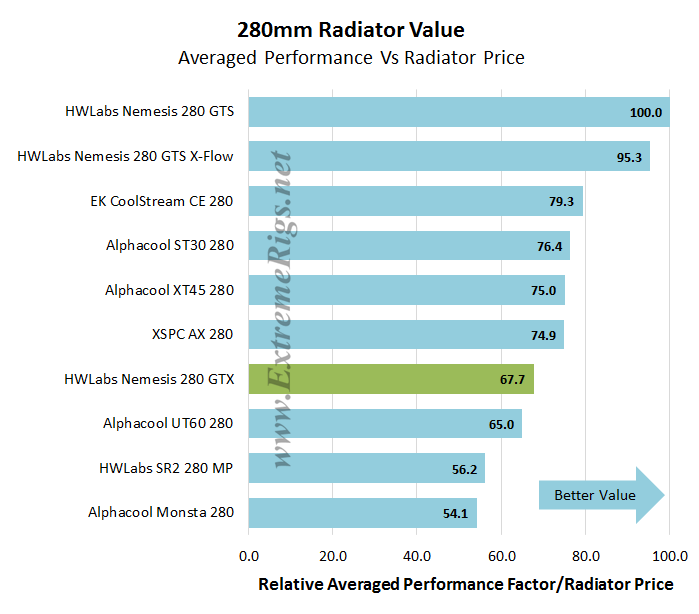 The Nemesis 280 GTX’s Value Factor turns out to be below the average of the group which was 74.5. This tells us that it does not offer outstanding value for the performance potential it offers. In reality the difference is not great, but when visualizing with percentages as we have done, the differences appear large.
The Nemesis 280 GTX’s Value Factor turns out to be below the average of the group which was 74.5. This tells us that it does not offer outstanding value for the performance potential it offers. In reality the difference is not great, but when visualizing with percentages as we have done, the differences appear large.
Generally value and space efficiency metrics usually correlate – thicker radiators do contain more material afterall and so are usually also more expensive. Once we factor thickness in, we realize that all the radiators that are better value are actually thinner.
Next Up – Summary!
![]()








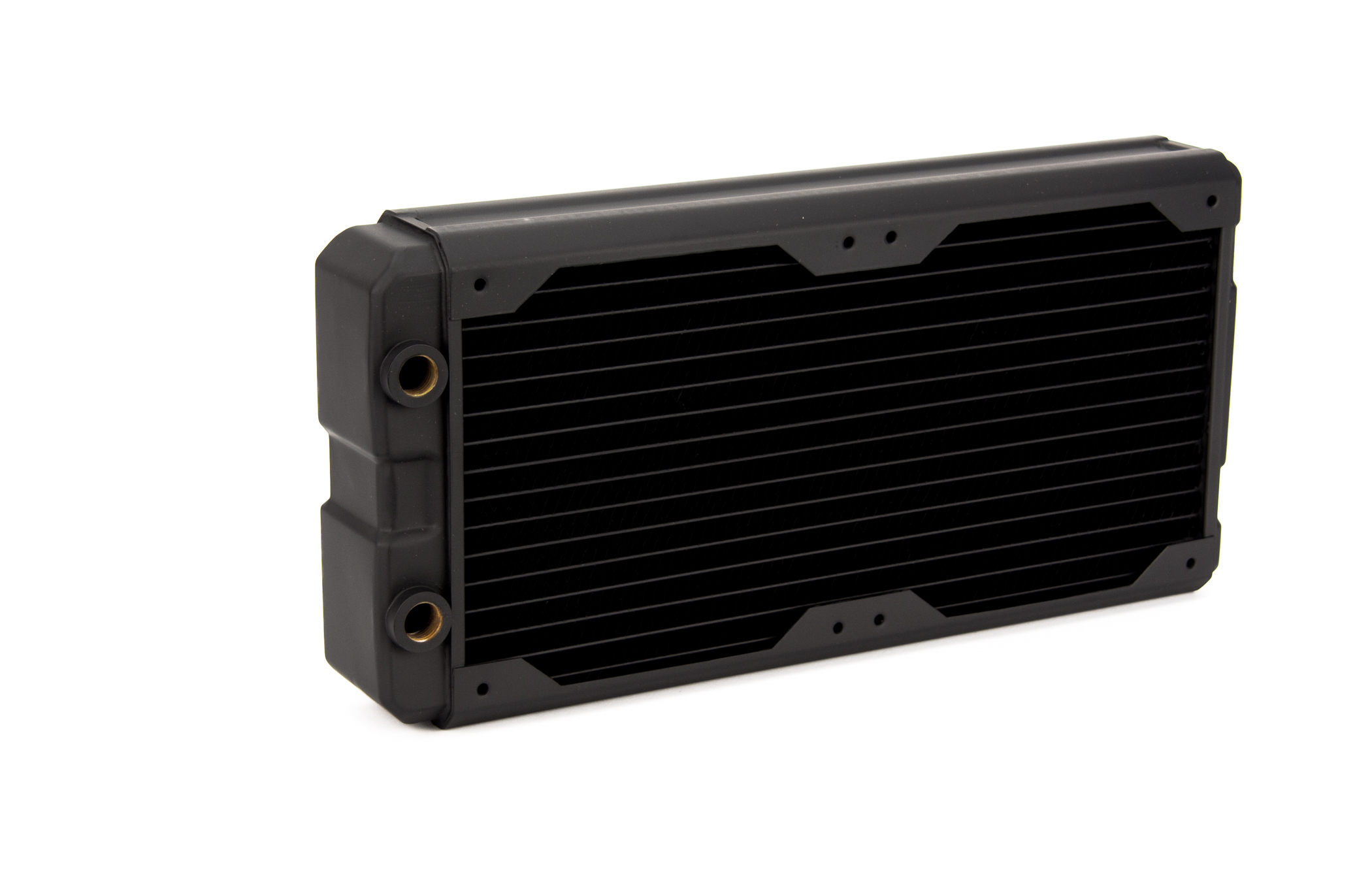
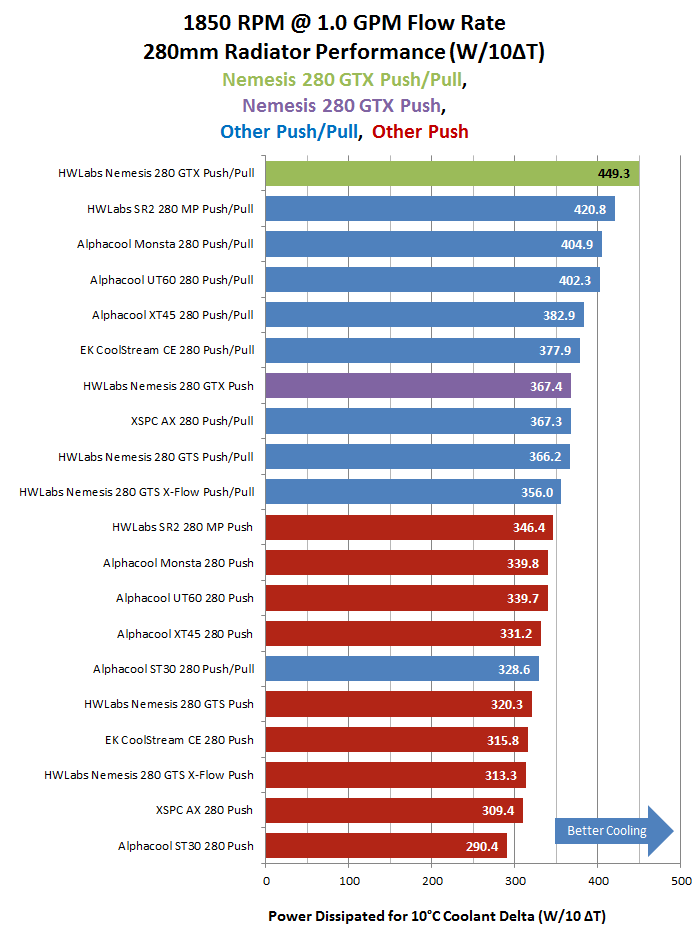

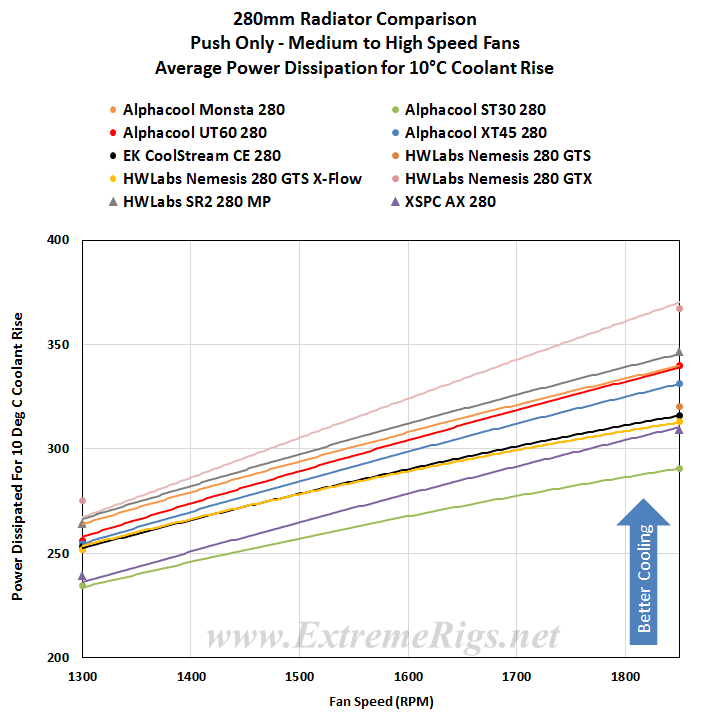
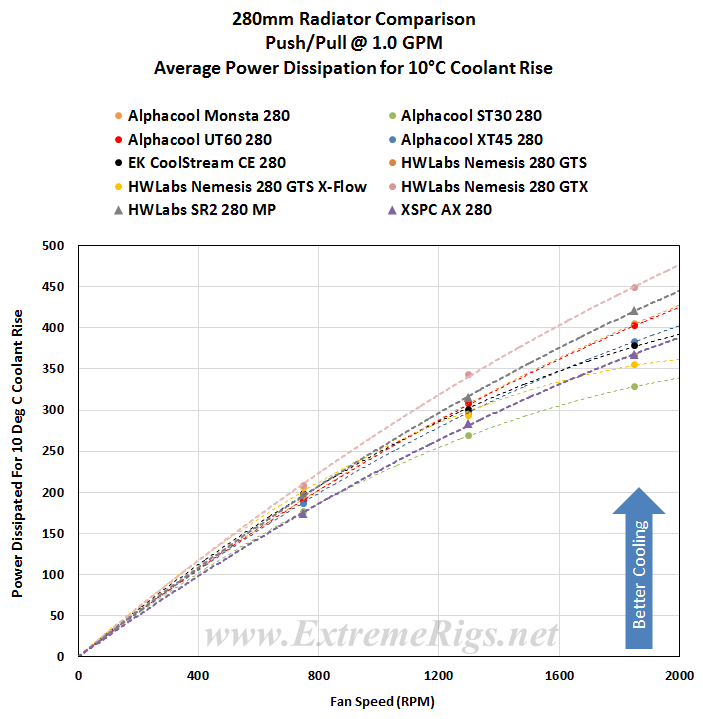
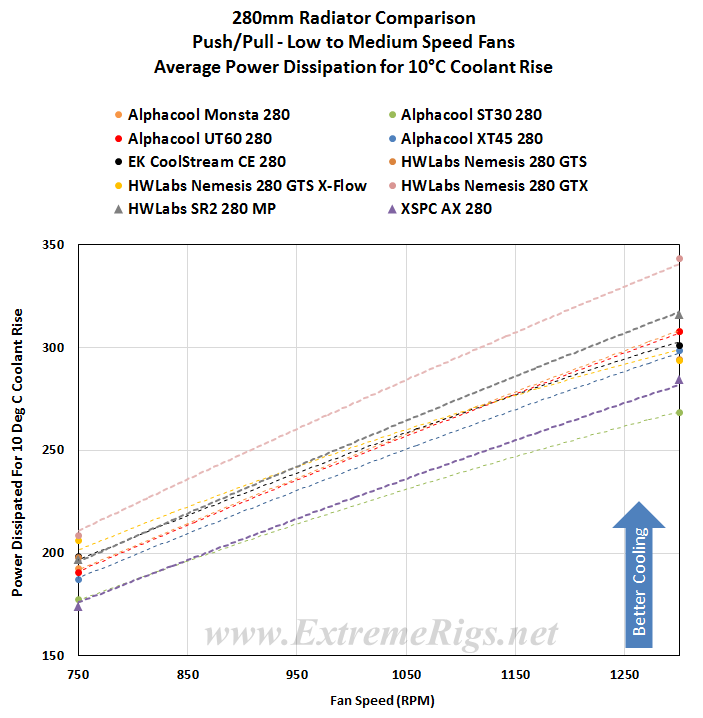
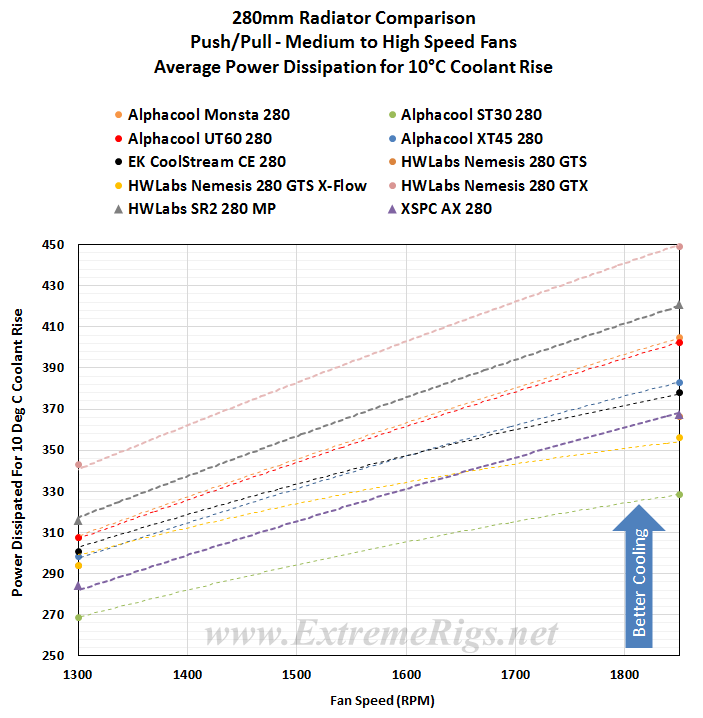



Why is such a thick rad not multiport? At least have 4 ports for easy top filling, and a temps sensor….. would help a ton.
Hey Drew – The Nemesis GTX rads have this front to back flow that makes adding alternative input/output ports quite hard because the end tank is split in half in the different way to a u-flow rad. Now that’s not to say it can’t be done with some tubes and more welding – but it would complicate things and push the price up. However ports could be added at both ends for functionality without being allowed for input/output – i.e. for filling/draining/temp sensors. This would give more functionality at least without requiring more complicated internal tubes and welding.
Comments are closed.